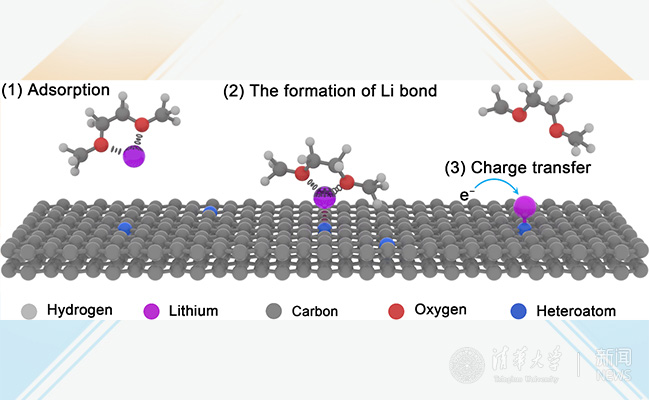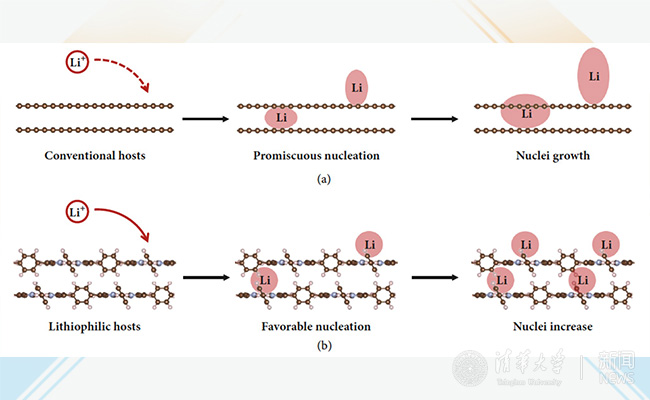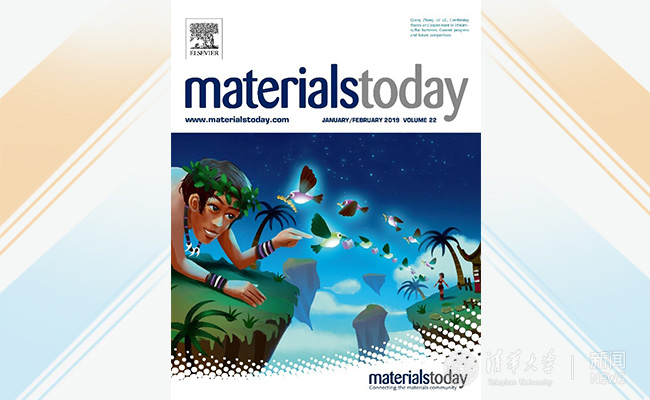Prof. Qiang Zhang’s group: Breakthrough in lithiophilicity chemistry and lithiophilic material design in lithium metal anodes
Recently, Professor Qiang Zhang’s group in Department of Chemical Engineering, Tsinghua University, published a paper entitled “Lithiophilicity Chemistry of Heteroatom-Doped Carbon to Guide Uniform Lithium Nucleation in Lithium Metal Anodes” in the journal of Science Advances and a paper entitled “Favorable Lithium Nucleation on Lithiophilic Framework Porphyrin for Dendrite-Free Lithium Metal Anodes” in the journal of Research. These work unveiled the lithiophilicity chemistry of carbon materials as lithium metal anode frameworks and proposed emerging lithiophilic materials to render a dendritic-free lithium metal anodes.
High-energy-density rechargeable batteries have been an increasing demand in modern society as the fast development and wide application of electric vehicles, portable devices, and large-scale smart grids. Lithium (Li) metal anodes, with an ultra-high specific capacity (3860 mAh g-1) and a very low electrode potential (-3.040 V vs. standard hydrogen electrode) are considered as one of the most promising negative electrode choices. However, Li metal anodes are facing challenging issues, such as the uncontrollable growth of Li dendrites and an infinite volumetric change during cycling. The growth of Li dendrites can result in “dead Li”, the loss of active electrode substance, and an irreversible reduce of capacity. Li dendrites can also promote the violent reaction between electrolytes and Li metal anodes, reducing the Coulombic efficiency and battery lifespan. More seriously, Li dendrites can even pierce through the separator, causing a short circuit and serve safety hazards. Recently, designing highly lithiophilic frameworks has been considered as a promising solution to retard the formation of Li dendrites and infinite volumetric change simultaneously. A deep sight into the lithiophilicity chemistry and constructing lithiophilic materials have been the key issues to achieve a dendrite-free Li metal anode. Recently, Prof. Qiang Zhang from Tsinghua University achieved a breakthrough in this area.

Schematic representation of the Li nucleation on conductive frameworks.
With the advantages of excellent electrical conductivity, low density, and facile synthesis, heteroatom-doped carbon materials were proposed to be lithium metal framework. The lithiophilicity of doping sites were proved through first-principles calculation combined with experimental characterizations. There principles were proposed to judge the lithiophilicity: the electronegativity of heteroatom, the “local dipole” of doping site, and the charge transfer during the Li nucleation process.
Specifically, the electronegativity difference between the heteroatom and carbon atoms is beneficial to form a negative charge site to strongly absorb a Li ion with positive charge. A strong “local dipole” can induce a strong ion–dipole force to further enhance the interaction between a Li ion and host materials. While an efficient charge transfer is necessary to reduce the nucleation barrier. Based on the calculation results, O-doping was predicted to have the best lithiophilicity among single doping, which was further validated by experimental Li nucleation tests. Comparing with single doping, O–B/P co-doping strategy was predicted to achieve even better performance. This work entitled “Lithiophilicity Chemistry of Heteroatom-Doped Carbon to Guide Uniform Lithium Nucleation in Lithium Metal Anodes” was published in the journal of Science Advances.

Schematic of Li nucleation on host materials with different lithiophilicities. (a) Conventional hosts with poor affinity of Li render promiscuous nucleation and dendrite growth. (b) Favorable Li nucleation on lithiophilic hosts with precisely constructed lithiophilic sites to afford dendrite-free Li metal anodes.
In order to achieve a uniform Li deposition and resist the formation of Li dendrites, a framework porphyrin (POF) material was designed. POF, which is constructed with porphyrin units through covalent bonds, can achieve precisely constructed lithiophilic sites in regard to chemical structure and geometric position. As the nature polarization and conjugate structure, the extraordinary lithiophilicity of POF even beyond Li nuclei affords the novel mechanism of favorable Li nucleation to render uniform Li deposition from dendrite growth. This work entitled “Favorable Lithium Nucleation on Lithiophilic Framework Porphyrin for Dendrite-Free Lithium Metal Anodes” was published in the journal of Research.
The journal Research, launching in 2018 as the first journal in the Science Partner Journal program, is the official journal of the China Association for Science and Technology. Research provides an international platform for academic exchange, collaboration and technological advancements. The journal aims to publish high-quality research from any research domain, from any author in the world. Topics of particular interest include, but are not limited to: Biology and life sciences, Micro- and nano-science, Artificial intelligence and information science, New energy studies, Mechanical science and engineering, Environmental science, Emerging materials research, Robotics and advanced manufacturing, and Technological applications of all research.

Cover picture in Materials Today, describing the cooperation between theory and experiments in Li–S batteries.
Qiang’s group was also invited to contribute a review entitled “Combining Theory and Experiment in Lithium–Sulfur Batteries: Current Progress and Future Perspectives” in the journal of Materials Today, cooperated with Prof. Kristin A. Persson from Department of Materials Science and Engineering, University of California Berkeley. The review summarized the difficulty and how to combine theory and experiments in Li–S batteries, affording a fancy paradigm for energy and material science researches.
There works were supported from the National Key Research and Development Program, the National Natural Scientific Foundation of China, Beijing Key Research and Development Plan from Beijing Municipal Science & Technology Commission, the Tsinghua University Initiative Scientific Research Program, and Tsinghua National Laboratory for Information Science and Technology.
Prof. Qiang Zhang is the corresponding author of the papers. Xiang Chen, a Ph.D. student, is the first author of the papers entitled “Lithiophilicity Chemistry of Heteroatom-Doped Carbon to Guide Uniform Lithium Nucleation in Lithium Metal Anodes” and “Combining Theory and Experiment in Lithium–Sulfur Batteries: Current Progress and Future Perspectives”. Boquan Li, Xiaoru Chen, and Xiang Chen, three Ph.D. students, are the co-first author of the paper entitled “Favorable Lithium Nucleation on Lithiophilic Framework Porphyrin for Dendrite-Free Lithium Metal Anodes”.
Prof. Qiang Zhang’s group aims to research the energy materials, energy chemistry, and related chemical engineering science. Highly efficient energy storage system is the core pillar of modern transportation, energy industry, and consumer electronics industry. Seeking high-capacity electrode materials, unveiling the working mechanism, and building high-energy-density systems have been the key issues in this area. In exploring Li–S batteries, which works on multi-electron chemistry, the group proposed the concepts of Li bond chemistry and ion–solvent complexes. Li–S pouch cells were further constructed based on SEI (solid electrolyte interphase)-protected Li metal anodes and carbon–sulfur hybrid cathodes. Nano frameworks were also introduced to stabilize the Li metal anodes though lithiophilicity chemistry. These works were published in the journal of Advanced Materials, Journal of the American Chemical Society, Angewandte Chemie-International Edition, Energy Storage Materials, Chem, Joule, Nature Communications, Science Advances, Proceedings of the National Academy of Sciences of the United States of America, and so on. Recently, the group published a paper entitled “Toward Safe Lithium Metal Anode in Rechargeable Batteries: A Review” in the journal of Chemical Review. The group also applied a series of Chinese patents and PCT patents.
Publication links:
Chen X, Chen XR, Hou TZ, Li BQ, Cheng XB, Zhang R, Zhang Q*. Lithiophilicity Chemistry of Heteroatom-Doped Carbon to Guide Uniform Lithium Nucleation in Lithium Metal Anodes. Sci. Adv. 2019, 5, eaau7728, DOI: 10.1126/sciadv.aau7728.
http://advances.sciencemag.org/content/5/2/eaau7728
Li BQ, Chen XR, Chen X, Zhao CX, Zhang R, Cheng XB, Zhang Q*. Favorable Lithium Nucleation on Lithiophilic Porphyrin Organic Frameworks for Dendrite-Free Lithium Metal Anodes. Research 2019, 2, 4608940.
https://spj.sciencemag.org/research/2019/4608940/
Chen X, Hou T, Persson, K A*, Zhang, Q*. Combining Theory and Experiment in Lithium–Sulfur Batteries: Current Progress and Future Perspectives. Mater. Today 2019, 22, 142–158.
https://www.sciencedirect.com/science/article/pii/S1369702118303511

